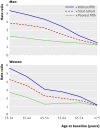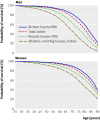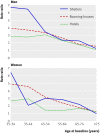Mortality among residents of shelters, rooming houses, and hotels in Canada: 11 year follow-up study
- PMID: 19858533
- PMCID: PMC2767481
- DOI: 10.1136/bmj.b4036
Mortality among residents of shelters, rooming houses, and hotels in Canada: 11 year follow-up study
Abstract
Objective: To examine mortality in a representative nationwide sample of homeless and marginally housed people living in shelters, rooming houses, and hotels.
Design: Follow-up study.
Setting: Canada 1991-2001.
Participants: 15 100 homeless and marginally housed people enumerated in 1991 census.
Main outcome measures: Age specific and age standardised mortality rates, remaining life expectancies at age 25, and probabilities of survival from age 25 to 75. Data were compared with data from the poorest and richest income fifths as well as with data for the entire cohort
Results: Of the homeless and marginally housed people, 3280 died. Mortality rates among these people were substantially higher than rates in the poorest income fifth, with the highest rate ratios seen at younger ages. Among those who were homeless or marginally housed, the probability of survival to age 75 was 32% (95% confidence interval 30% to 34%) in men and 60% (56% to 63%) in women. Remaining life expectancy at age 25 was 42 years (42 to 43) and 52 years (50 to 53), respectively. Compared with the entire cohort, mortality rate ratios for men and women, respectively, were 11.5 (8.8 to 15.0) and 9.2 (5.5 to 15.2) for drug related deaths, 6.4 (5.3 to 7.7) and 8.2 (5.0 to 13.4) for alcohol related deaths, 4.8 (3.9 to 5.9) and 3.8 (2.7 to 5.4) for mental disorders, and 2.3 (1.8 to 3.1) and 5.6 (3.2 to 9.6) for suicide. For both sexes, the largest differences in mortality rates were for smoking related diseases, ischaemic heart disease, and respiratory diseases.
Conclusions: Living in shelters, rooming houses, and hotels is associated with much higher mortality than expected on the basis of low income alone. Reducing the excessively high rates of premature mortality in this population would require interventions to address deaths related to smoking, alcohol, and drugs, and mental disorders and suicide, among other causes.
Conflict of interest statement
Competing interests: None declared.
Figures




References
-
- Davey Smith G, ed. Health inequalities: lifecourse approaches. Policy Press, 2003.
-
- Lantz PM, House JS, Lepkowski JM, Williams DR, Mero RP, Chen J. Socioeconomic factors, health behaviors, and mortality: results from a nationally representative prospective study of US adults. JAMA 1998;279:1703-8. - PubMed
-
- Canadian Mortgage Housing Corporation. Research highlight: profile of rooming house residents. 2006. www.cmhc-schl.gc.ca/odpub/pdf/65235.pdf.
Publication types
MeSH terms
Grants and funding
LinkOut - more resources
Full Text Sources
Medical
